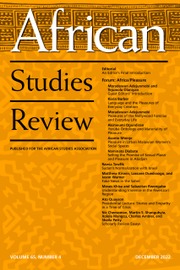This fascinating environmental history of Lesotho insists that while colonial and missionary actors in the nineteenth and twentieth centuries imposed Western thinking, values, and technology on Basutoland within relations of unequal power, Basotho also had agency and creativity in how new knowledge and practices were created. Cronz traces how Basotho formed and embraced notions of “progress” (Sesotho: tsoelopele) that were not simply an adoption of Western ideas and values, but profoundly rooted in place, history, and culture.
Following an Introduction, a first chapter outlines how Boer encroachment on the lowlands led to seeking British protection in the late nineteenth century, and significant multiethnic retreat into the mountains, where there were still many wild animals such as lions, elands, and crocodiles, and of course, San peoples. The highland environments changed rapidly with settlement, cattle, sheep, and goats, and while missionaries promoted horticulture and new crops, Basotho selected and adopted crops such as wheat, potatoes, maize, peas, lentils, and fruit trees on their own terms. The arrival of the plough massively expanded cultivation in the highland grasslands, contributing to erosion, and changing gendered divisions of labor in farming, as well as spurring socioeconomic differentiation. Most importantly, however, Cronz argues that the imposition of a colonial capitalist political economy based on export-oriented production of merino wool from sheep and mohair from goats (displacing traditional food source flat-tailed sheep), set Basutoland on a path of poverty and dependency—“the poverty of progress” or “slow violence”—as well as ecological change and deterioration. Changes in grasses and other vegetation as a result of intensified grazing of these animals, for example, degraded pastureland, increased soil fragility, and widened differences between the poor and the better off.
In five chapters, Cronz then selects key colonial-led interventions, including veterinary, forestry, soil management, agricultural, and nutrition programs, illustrating how these participated in wider colonial discourses and practices (for example, the soil science emerging from the US dust bowl of the 1930s and microbial veterinary science in the United Kingdom), and often misread both the landscape and the Basotho people, leading to detrimental ecological and social impacts. A stark example is the widespread malnutrition that emerged in the twentieth century, directly linked to the change to refined maize-based diets, and removal of much male labor from subsistence livelihoods through the large-scale labor migration to South Africa’s farms and mines. Colonial officials also mistakenly assumed that the mountain regions had been previously forested and promoted ill-conceived forestation programs they believed would combat erosion as well as protect mountain water source areas that were deemed critical for downstream water availability in the Orange Free State and elsewhere in South Africa. Labor-intensive soil management and erosion control measures, such as the back-breaking work of building contour ridges and placing rocks in gullies, were not only largely ineffective, and often counterproductive, but also disrupted traditional communal labor regimes that had historically maintained communal grazing, social welfare, and chiefly authority. Colonial programs to intensify cropping practices, for example to extend cropping into winter months in the name of increasing productivity and food security, had the effect of disrupting chiefs’ authority over land allocation, traditional winter grazing of animals on harvested fields, and the regenerative effects of leaving fields fallow for periods.
In this narration, however, Cronz also insists that Basotho were not passive but engaged with new ideas thoughtfully and strategically, with a strong thread of protecting Basotho independence and future sovereignty under the constant threat of absorption into the Cape and then the Republic of South Africa. Cronz highlights important Basotho innovators, thinkers, and leaders, the key roles of chiefs and the diverse political parties leading up to independence in the 1960s, in a nuanced and detailed account. Some held radical, anti-colonial and pan-African views, while others were more eclectic in embracing some “modern” ideas, technologies, and Christianity. Cronz also draws out important gender threads, emphasizing how changes in the political economy and culture drove changes in gendered divisions of labor, women’s livelihood strategies such as in keeping “women’s cattle” (pigs), and opportunities for women through Christianization, such as the influential and widespread Homemakers Association.
This book is soundly based on thorough archival research, oral history and scholarly literature, and grounded in extensive time in the field. It will interest scholars of this unique country, as well as those of southern Africa, and environmental history more generally.

